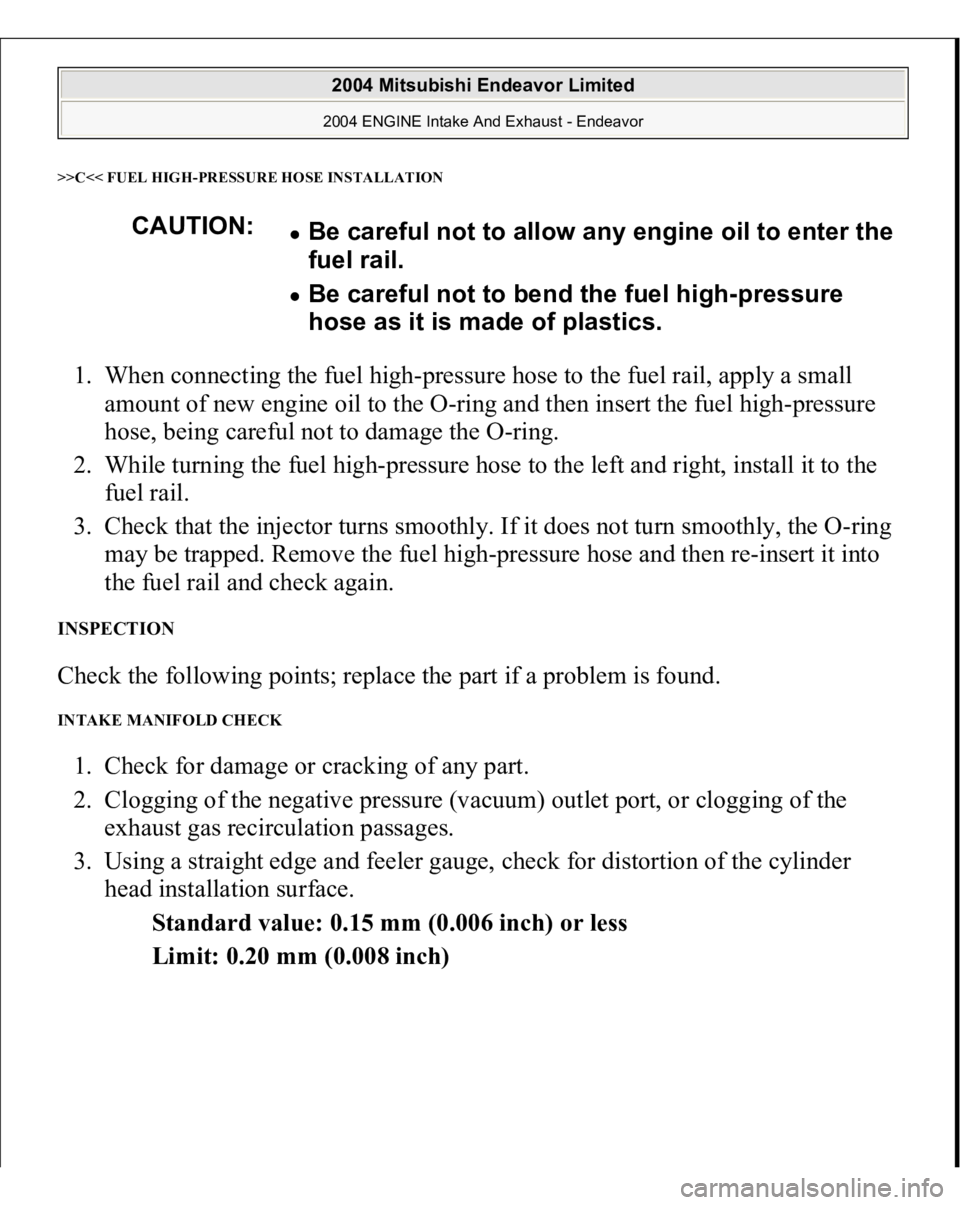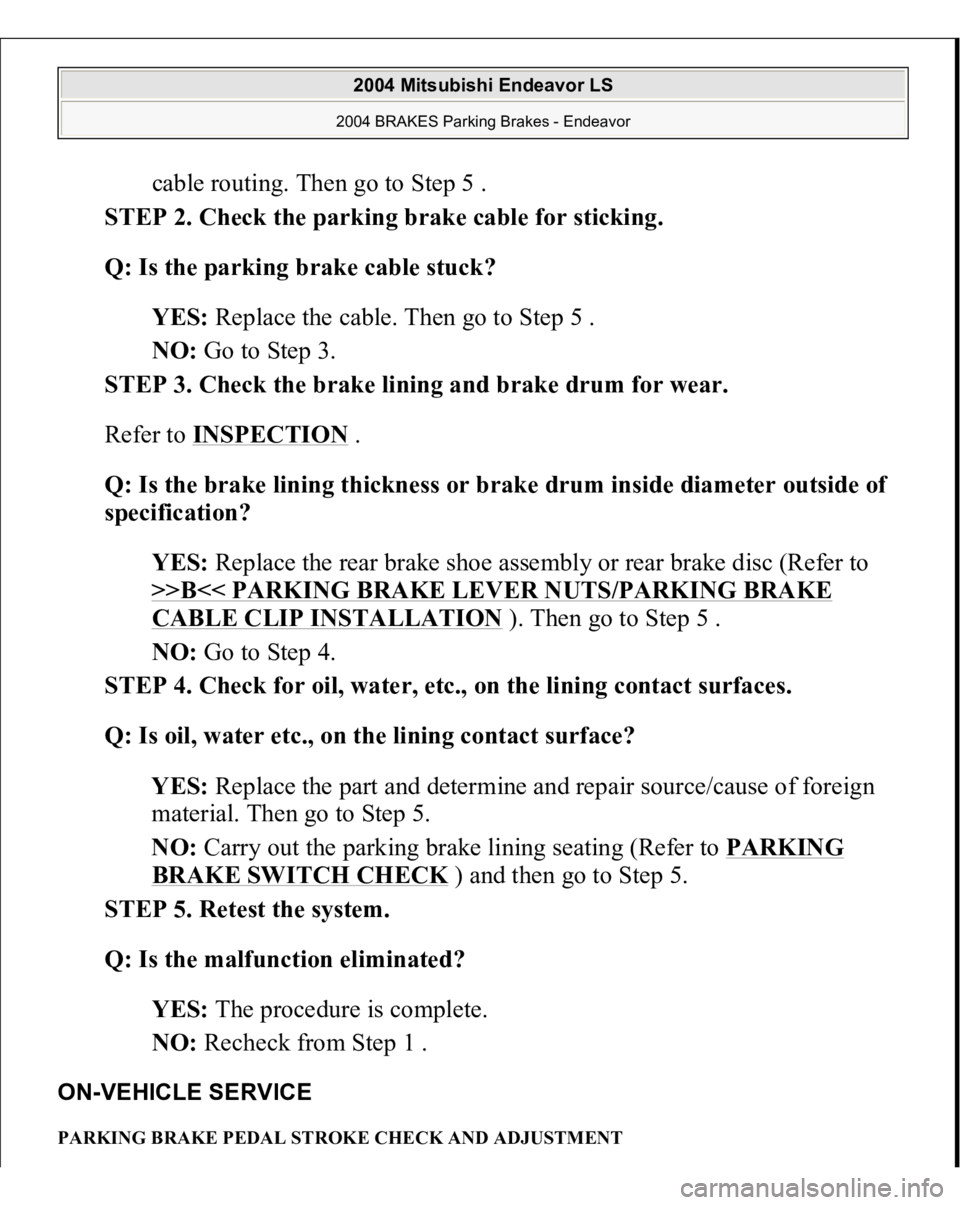Page 2687 of 3870
SPARK PLUG TEST 1. Remove the spark plug and connect to the ignition coil.
Fig. 5: Removing Spark Plug
Courtesy of MITSUBISHI MOTOR SALES OF AMERICA.
2. Ground the spark plug outer electrode (body), and crank the engine.
Check that there is an electrical dischar
ge between the electrodes at this time.
2004 Mitsubishi Endeavor Limited 2004 ENGINE Ignition System - Endeavor
Page 2690 of 3870
IGNITION COI
L
REMOVAL AND INSTALLATION Fig. 8: Removing And Installing Ignition Coil
Courtesy of MITSUBISHI MOTOR SALES OF AMERICA.
CAMSHAFT POSITION SENSOR REMOVAL AND INSTALLATION
2004 Mitsubishi Endeavor Limited 2004 ENGINE Ignition System - Endeavor
Page 2715 of 3870
>>B<< INTAKE MANIFOLD INSTALLATIONFig. 6: Identifying Intake Manifold
Courtesy of MITSUBISHI MOTOR SALES OF AMERICA.
1. Coat the intake manifold mounting studs with engine oil.
2. Tighten the intake manifold mounting nuts by the following procedure.
INTAKE MANIFOLD INSTALLATION
ORDER
MOUNTING NUTS
TIGHTENING TORQUE
1st
Right-bank nuts
6.5+/-1.5 N.m (58+/-13 in-lb)
2nd
Left-bank nuts
22+/-1 N.m (16+/-1 ft-lb)
3rd
Right-bank nuts
22+/-1 N.m (16+/-1 ft-lb)
4th
Left-bank nuts
22+/-1 N.m (16+/-1 ft-lb)
5th
Right-bank nuts
22+/-1 N.m
(16+/-1 ft-lb
)
2004 Mitsubishi Endeavor Limited 2004 ENGINE Intake And Exhaust - Endeavor
Page 2716 of 3870

>>C<< FUEL HIG
H-PRESSURE HOSE INSTALLATION
1. When connecting the fuel high-pressure hose to the fuel rail, apply a small
amount of new engine oil to the O-ring and then insert the fuel high-pressure
hose, being careful not to damage the O-ring.
2. While turning the fuel high-pressure hose to the left and right, install it to the
fuel rail.
3. Check that the injector turns smoothly. If it does not turn smoothly, the O-ring
may be trapped. Remove the fuel high-pressure hose and then re-insert it into
the fuel rail and check again. INSPECTION Check the following points; replace the part if a problem is found. INTAKE MANIFOLD CHECK 1. Check for damage or cracking of any part.
2. Clogging of the negative pressure (vacuum) outlet port, or clogging of the
exhaust gas recirculation passages.
3. Using a straight edge and feeler gauge, check for distortion of the cylinder
head installation surface.
Standard value: 0.15 mm (0.006 inch) or less
Limit: 0.20 mm (0.008 inch)
CAUTION:
Be careful not to allow any engine oil to enter the
fuel rail. Be careful not to bend the fuel high-pressure
hose as it is made of plastics.
2004 Mitsubishi Endeavor Limited 2004 ENGINE Intake And Exhaust - Endeavor
Page 2789 of 3870

cable routing. Then go to Step 5 .
STEP 2. Check the parking brake cable for sticking.
Q: Is the parking brake cable stuck?
YES: Replace the cable. Then go to Step 5 .
NO: Go to Step 3.
STEP 3. Check the brake lining and brake drum for wear.
Refer to INSPECTION
.
Q: Is the brake lining thickness or brake drum inside diameter outside of
specification?
YES: Replace the rear brake shoe assembly or rear brake disc (Refer to
>>B<< PARKING BRAKE LEVER NUTS/PARKING BRAKE
CABLE CLIP INSTALLATION
). Then go to Step 5 .
NO: Go to Step 4.
STEP 4. Check for oil, water, etc., on the lining contact surfaces.
Q: Is oil, water etc., on the lining contact surface?
YES: Replace the part and determine and repair source/cause of foreign
material. Then go to Step 5.
NO: Carry out the parking brake lining seating (Refer to PARKING
BRAKE SWITCH CHECK
) and then go to Step 5.
STEP 5. Retest the system.
Q: Is the malfunction eliminated?
YES: The procedure is complete.
NO: Recheck from Step 1 .
ON-VEHICLE SERVICE PARKING BRAKE PEDAL STROKE CHECK AND ADJUSTMENT
2004 Mitsubishi Endeavor LS 2004 BRAKES Parking Brakes - Endeavor
Page 2815 of 3870
2004 STEERING
Power Steering - Endeavor
GENERAL DESCRIPTION Power steering has been adopted in all vehicles to make the steering system easier
to handle.
A 4-spoke steering wheel is used. A steering column has a shock absorbing mechanism and a tilt steering
mechanism. A rack and pinion steering gear is used. An oil pump responsive to engine RPM is used, which, with tuning for a rigid
gear box mount, improves steering stability at high speeds. The separate plastic resin oil reservoir reduces weight and makes fluid level
checking easier.
Fig. 1: Identifying Power Steering Components
Courtesy of MITSUBISHI MOTOR SALES OF AMERICA.
POWER STEERING DIAGNOSIS
2004 Mitsubishi Endeavor LS
2004 STEERING Power Steering - Endeavor
2004 Mitsubishi Endeavor LS
2004 STEERING Power Steering - Endeavor
Page 2816 of 3870
INTRODUCTION TO POWER STEERING DIAGNOSISHydraulic power steering is used for all vehicles. Faults in the power steering can
include excessive play of the steering wheel, difficult steering wheel operation,
noise, vibration, and oil leaks, etc. Possible causes of these faults can include
defects in the gear box, oil pump or steering linkage. POWER STEERING DIAGNOSIS TROUBLESHOOTING STRATEGY Use these steps to plan your diagnostic strategy. If you follow them carefully, you
will be sure that you have exhausted most of the possible ways to find a power
steering fault.
1. Gather information from the customer.
2. Verify that the condition described by the customer exists.
3. Find the malfunction by following the Symptom Chart.
4. Verify malfunction is eliminated. SYMPTOM CHART
2004 Mitsubishi Endeavor LS
2004 STEERING Power Steering - Endeavor
Page 2820 of 3870

YES: Repeat from Step 1 .
NO: The procedure is complete.
INSPECTION PROCEDURE 2: DIFFICULT STEERING WHEEL OPERATION (INSUFFICIENT POWER ASSIST) DIAGNOSIS
STEP 1. Check the drive belt for damage.
Q: Is the drive belt damaged?
YES: Replace the drive belt. Then go to Step 9 .
NO: Go to Step 2.
STEP 2. Check the power steering oil pump drive belt tension.
Refer to 7. DRIVE BELTS (FOR GENERATOR, POWER STEERING OIL PUMP AND AIR CONDITIONING) (CHECK)
.
Q: Is the power steering oil pump drive belt tension within the standard
value?
YES: Go to Step 3.
NO: Adjust the tension. (Refer to 7. DRIVE BELTS (FOR
GENERATOR, POWER STEERING OIL PUMP AND AIR CONDITIONING) (CHECK)
). Then go to Step 9 .
STEP 3. Check the fluid level.
1. Park the vehicle on a flat, level surface, and then start the engine.
2. Turn the steering wheel several times to raise the temperature of the fluid
to approximately 50 - 60°C (122 - 140°F).
3. With the engine running, turn the wheel all the way to the left and right
several times.
4. Check the fluid in the oil reservoir for foaming or milkiness. Check the
difference of the fluid level when the engine is stopped, and while it is
running.
Q: Is the check result OK?
2004 Mitsubishi Endeavor LS
2004 STEERING Power Steering - Endeavor